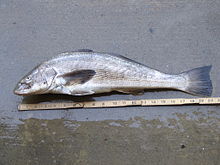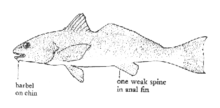- California corbina
-
California corbina Scientific classification Kingdom: Animalia Phylum: Chordata Class: Actinopterygii Order: Perciformes Family: Sciaenidae Genus: Menticirrhus Species: M. undulatus Binomial name Menticirrhus undulatus
(Girard, 1854)The California corbina (Menticirrhus undulatus) is a saltwater fish and member of the croaker family. California corbina occur from the Gulf of California, Mexico, to Point Conception, California. It is a bottom fish found along sandy beaches and in shallow bays. This species travels in small groups along the surf zone in a few inches of water to depths of 45 feet (14 m). The largest recorded specimen was 28 inches (710 mm) and 8.5 pounds. Other names include "California kingcroaker," "California whiting," and "sucker." California corbina should not be confused with corvina, which are taken in the Salton Sea and Gulf of California.
Contents
Description
The body of the California corbina is elongate and slightly compressed. The head is long and the mouth is small, the upper jaw scarcely reaching a point below the front of the eye. The color is uniform grey with iridescent reflections, and with wavy diagonal lines on the sides. This croaker and the yellowfin croaker are the only two of the eight coastal croakers present in California waters to have a single fleshy projection, or barbel, on the lower jaw. The California corbina usually has only one weak spine at the front of the anal fin, while the yellowfin croaker has two strong spines. The caudal fin (tail) is unusual in that the upper half has a concave trailing edge, the lower half trailing edge is convex.
Natural history
Adults have been seen feeding in the surf, at times in water so shallow that their backs were exposed. They scoop up mouthfuls of sand and separate the food by sending the sand through the gills. They are very particular feeders, apparently spitting out bits of clam shells and other foreign matter. About 90 percent of the food they eat is sand crabs – Emerita analoga. Other crustaceans and clams are of lesser importance. Males mature when 2 years old at a length of about 10 inches and females at age 3 when about 13 inches long. Spawning extends from June to September, but is heaviest during July and August. Spawning apparently takes place offshore as running ripe fish are not often found in the surf zone. The eggs are free floating. Young corbina, 1 inch long, have been observed outside the surf in 4–8 feet (1.2–2.4 m) of water in August. They travel in large groups, commonly known as the "fish of the sea."
Fishing information
California corbina are caught throughout the year along southern California's sandy beaches, although fishing is at its best from July through September. They are very wary and difficult to hook as many an avid surf fisherman can affirm. Perhaps one reason is that they tend to mouth and chew their food and don't strike solidly very often. Sand crabs (usually softshells) are the preferred bait, though some anglers swear by blood worms, mussels, clams, pileworms, and ghost shrimp[disambiguation needed
 ].
].Corbina are sometimes referred to as "Beans," and for the surf fisherman is one of the most prized catches. The Beans, sometimes also referred to a "Sliders" are seen in the summer months as the water warms and the sand crab beds appear in the sand. As an incoming tide fills in the holes, troughs and structure in the beach, Corbina will come in with an incoming wash and utilize the barbel they have under their chin to dig and sometimes can be seen "tailing" for sand crabs. For anglers who prefer to fly fish in the surf, they are especially difficult to bring to hand. The fly patterns they prefer and will hit represent sand crabs, blood worms and other crustaceans.
Although, these fish are difficult to hook, even an amateur spear fisher can easily spear these fish as they are not very wary of human contact. Corbina are the perfect fish to learn how to aim and shoot your spear due to the fishes lack of fight/flight reaction.
References
- California Marine Sportfish, California Department of Fish and Game, Marine Region; a public domain resource.[1]
Categories:- Sciaenidae
- Western North American coastal fauna
- Fish of the Gulf of California
- Animals described in 1854
Wikimedia Foundation. 2010.


